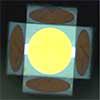Our official English website, www.x-mol.net, welcomes your feedback! (Note: you will need to create a separate account there.)
Electro-mechano-optical detection of nuclear magnetic resonance
Optica ( IF 10.4 ) Pub Date : 2018-02-02 , DOI: 10.1364/optica.5.000152 Kazuyuki Takeda , Kentaro Nagasaka , Atsushi Noguchi , Rekishu Yamazaki , Yasunobu Nakamura , Eiji Iwase , Jacob M. Taylor , Koji Usami
Optica ( IF 10.4 ) Pub Date : 2018-02-02 , DOI: 10.1364/optica.5.000152 Kazuyuki Takeda , Kentaro Nagasaka , Atsushi Noguchi , Rekishu Yamazaki , Yasunobu Nakamura , Eiji Iwase , Jacob M. Taylor , Koji Usami

|
Signal reception of nuclear magnetic resonance (NMR) usually relies on electrical amplification of the electromotive force caused by nuclear induction. Here, we report up-conversion of a radio-frequency NMR signal to an optical regime using a high-stress silicon nitride membrane that interfaces the electrical detection circuit and an optical cavity through the electro-mechanical and the opto-mechanical couplings. This enables optical NMR detection without sacrificing the versatility of the traditional nuclear induction approach. While the signal-to-noise ratio is currently limited by the Brownian motion of the membrane as well as additional technical noise, we find it can exceed that of the conventional electrical schemes by increasing the electro-mechanical coupling strength. The electro-mechano-optical NMR detection presented here opens the possibility of mechanical parametric amplification of NMR signals. Moreover, it can potentially be combined with the laser cooling technique applied to nuclear spins.
中文翻译:

核磁共振的电光检测
核磁共振(NMR)的信号接收通常依赖于由核感应引起的电动势的电放大。在这里,我们报告使用高应力氮化硅膜将射频NMR信号上转换为光学状态,该高应力氮化硅膜通过机电耦合和光电耦合将电检测电路和光腔连接起来。这样就可以进行光学NMR检测,而不会牺牲传统核感应方法的多功能性。虽然信噪比目前受到膜的布朗运动以及其他技术噪声的限制,但我们发现通过提高机电耦合强度,它可以超过常规电气方案的信噪比。此处提出的电光NMR检测为NMR信号的机械参数放大打开了可能性。而且,它有可能与应用于核自旋的激光冷却技术相结合。
更新日期:2018-02-21
中文翻译:

核磁共振的电光检测
核磁共振(NMR)的信号接收通常依赖于由核感应引起的电动势的电放大。在这里,我们报告使用高应力氮化硅膜将射频NMR信号上转换为光学状态,该高应力氮化硅膜通过机电耦合和光电耦合将电检测电路和光腔连接起来。这样就可以进行光学NMR检测,而不会牺牲传统核感应方法的多功能性。虽然信噪比目前受到膜的布朗运动以及其他技术噪声的限制,但我们发现通过提高机电耦合强度,它可以超过常规电气方案的信噪比。此处提出的电光NMR检测为NMR信号的机械参数放大打开了可能性。而且,它有可能与应用于核自旋的激光冷却技术相结合。


























 京公网安备 11010802027423号
京公网安备 11010802027423号